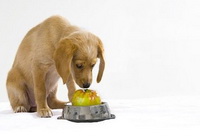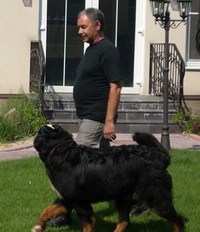Homemade Puppy Food
 Experience shows that a dog needs a special diet that is different from the traditional menu of the host table. And above all, the body of a growing puppy requires a large amount of high-grade protein contained in the tissues and organs of animals. The general lack of protein intake from food leads to nitrogen starvation, a decrease in the protective function of the immune system, hormonal disruptions, slower growth and weakness of the musculoskeletal system.
Experience shows that a dog needs a special diet that is different from the traditional menu of the host table. And above all, the body of a growing puppy requires a large amount of high-grade protein contained in the tissues and organs of animals. The general lack of protein intake from food leads to nitrogen starvation, a decrease in the protective function of the immune system, hormonal disruptions, slower growth and weakness of the musculoskeletal system.
The most important source of complete protein is muscular meat. Some owners go to extremes and feed their animals exclusively with meat feed. However, excess protein in food is no less harmful than its deficiency, as it can cause toxic effects in the body, which most often affect the liver and kidneys. In order to preserve health in the diet of domestic dogs, meat should be 25–35% of the total caloric content of food.
The most suitable meat product for a sensitive stomach is boiled chicken skinless. For small puppies at the age of 1–2 months, you can also make a staple from very lean raw veal or young beef, which is fed in the form of small balls. Lamb and lean lamb are also good meat foods. Turkey and rabbit meat, beef and horse meat are also used for feeding older puppies. Raw meat is healthier than boiled, but it can be fed to dogs only after a veterinary examination of carcasses. Meat must be cut into pieces in accordance with the size of the dog or used in the form of minced meat. A puppy at the age of 1-2 months is fed 200 g of meat per day; from 2 to 4 months – 400 g; from 4 to 6 months – 500 g; from 6 months to 1 year – 600 g.
Adult dogs are happy to eat beef offal: meat trim, diaphragm, stomach, kidneys, liver, tongue, spleen, heart, lungs, trachea, udder. The diaphragm is close in its chemical composition to muscular meat and is very nutritious. The liver is an excellent dietary product, a source of complete protein and the richest natural source of vitamins. When it freezes, the content of vitamin A is reduced. The liver is especially useful in youngsters, but it has some laxative effect on the intestines. Sometimes the larvae of parasitic worms are localized in the liver, so it is best to feed this product boiled. The heart as a type of muscle tissue is a valuable meat product containing vitamins of group B. The most valuable parts of the beef stomach are scar and rennet. When processing the stomach is cleaned from the parted grass and washed thoroughly under running water. When fresh, this by-product is saturated with enzymes and beneficial microflora, and dogs really like its specific smell and taste.
The lungs have a low calorie content, as they consist of a large amount of connective tissue. With poor veterinary control, raw lungs can be a source of tuberculosis, so heat treatment is obligatory. Boiled lungs need to be well ground when fed to a dog to avoid vomiting. Kidneys cut lengthwise must be soaked in cold water and then replaced again. The spleen is rich in essential amino acids, contains antibodies and enzymes. Nutritionally, it is close to the liver, but it must be exceptionally fresh. An early sign of damage to the spleen – darkening of the slice. Udder contains a large amount of fat, which determines its nutritional value. Brains contain a lot of lipids and choline, so they are fed to dogs with low condition and physical activity. This by-product quickly deteriorates, acquiring a greasy consistency and an unpleasant smell. Brains, udders, spleens, lungs and kidneys should not be given to dogs with a sensitive stomach or with diseases of the digestive tract. These by-products are introduced into the diet of healthy young dogs from 6 months of age.
Products for home nutrition of a puppyAfter changing teeth, neck and broiler chickens are also a valuable food. Be sure to remove the beaks to avoid irritation and injury to the esophagus. Some owners previously “beat off” the heads and necks with the blunt side of an ax to crush bones. Dogs are also happy to eat chicken and turkey hearts, liver and stomachs (“navels”). It is better not to give raw bird’s paws, as puppies often swallow them whole. You can cook the meaty legs of broilers and, after cooling, brush off the flesh from the stones.
Peeled beef heads can be successfully used as a source of high-quality protein for dogs. They are chopped into large pieces and cooked in a large saucepan over low heat. After 2-3 hours of cooking, the meat is easily separated from the bones. When cooled, the broth freezes no worse than brawn, so that this product can be fed in crushed form even to monthly puppies. In no case should dogs bite the remaining boiled bones of the beef skull, as they are very hard and can damage the digestive tract.



